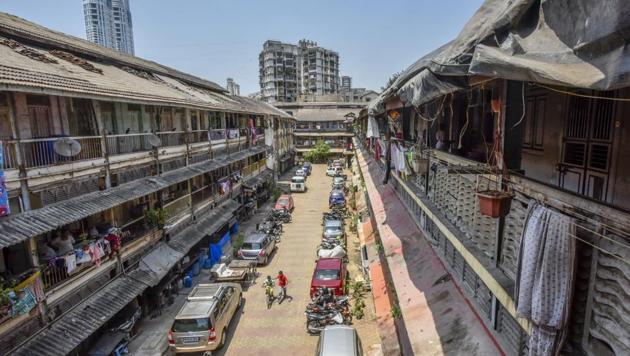There’s room for everyone: How Mumbai’s chawls have been housing people for 117 years
A large part of Mumbai’s character flourishes in its chawls, which could soon become history with the state government’s push for a revamp of these iconic structures
Glen Martis, 45, was worried after his son, Alston, was diagnosed with acute anaemia. He, however, found solace in one thing. He knew if his son ever developed convulsions in his absence, his neighbours at Tambawala Trust building — a chawl at Dongri — would rush to his son’s aid, arrange for help and would even wait at any hospital.

Martis’ situation symbolises Mumbai’s chawl culture — where one floor of a multi-storied building comprises houses in a single row with a common verandah and toilets. Think of a joint family, but one in which its members are not related by blood. All residents, despite their small skirmishes, would celebrate festivals together and lend a helping hand to each other in times of crises.
But all this is set to change, as chawls in the city have begun to give way to skyscrapers following government orders. Those who lived in cramped, 100-200-square feet houses for decades are to be shifted to 260-square feet apartments with toilets
For Martis, it is a tough choice as he is worried whether one can retain the same kind of kinship he enjoys now. But then, with his building in a dilapidated state and the surrounding clamour for big houses, which offer both privacy as well as accommodate a growing family, shifting to a new place is imperative.
When it all began
Chawls were first built in 1900, when the then British government encouraged many traders to set up textile mills here. These mills needed labour and the workers — mostly from the coastal Konkan region — made a beeline for jobs here. In order to ensure houses for these labourers close to their mills, these dwellings were constructed in 100-200 square-feet areas by mill owners. Taking advantage of this situation, many landlords also constructed chawls as rent was a source of lucrative income for them. As Mumbai grew, the workers then started bringing their families to the city and lived with them in these chawls. The children were sent to municipal schools. Freedom fighter Lokmanya Tilak started the Ganeshotsav festival from Keshavji Naik chawl in Girgaum with the whole aim of bringing people together. In the freedom movement, chawls played a vital role with many youngsters jumping into it.

The ‘chawl culture’
These chawls had a large verandah as well as a big ground where children could play. In the night, adults would take a stroll in the compound, which also served as a meeting point for the residents. In these chawls, various festivals like Ganpati, Dahi Handi and Diwali were celebrated with gusto. In case of weddings and functions, as people could not afford halls, a pandal used to be erected at the ground and the whole function used to take place there. In case of a celebration at someone’s house, all the women in the chawls would come together and cook for the guests. The exchange of commodities like sugar, milk and other eatables is commonplace in these chawls. The chawl culture also played its role in Marathi literature and theatre. The ‘workers theatre’ also gifted a number of playwrights and actors to Marathi theatre. The ‘chawl culture’ has been portrayed in the works of several Marathi litterateurs like P L Deshpande. Socialist and leftist parties also got tremendous support from the tenants of these chawls for a few decades since the 1940s and 50s.
The textile boom and dip
Most chawl dwellers worked in the textile mills. Many of them also managed to get their children jobs in these mills once they grew up. The Shiv Sena, which was started in 1966, was able to attract youths from these chawls. Top leaders like Manohar Joshi, Vithal Chavan, Dattaji Nalawade, Wamanrao Mahadik and Suryakant Desai all trace their origins to these chawls. But, in January 18, 1982, the entire textile sector went on strike, which proved to be a death knell and the strike’s direct effect was borne by chawls. As the strike lingered on, many mill workers sold their houses and returned to their villages or went to the distant suburbs. Many unemployed youths began to get attracted to the underworld. Chawls like Dagdi Chawl at Byculla and 144 tenements at Chinchpokli gained notoriety as it became a recruitment place for gangsters
At present
Currently, chawls pose to be lucrative real-estate for builders. From the government’s point of view, chawls offer a great opportunity to offer affordable houses after rehabilitating the existing tenants. The BDD chawls spread across 92.86 acres in prime areas like Lower Parel, Worli, Naigaon and Sewri promises to be a well-designed township with all modern amenities for its residents. Next on the block are the 133 Bombay Improvement Trust (BIT) chawls — located in prime areas such as Mumbai Central, Agripada, Sion, Parel and Mazgaon — another potential goldmine in the space-starved city. Apart from these are the chawls owned by textile mills, which are also set to be redeveloped. The chawls owned by landlords are also on the revamp radar, but now the recession in the real-estate market has slowed down the entire process. For how long the remaining chawls will survive is anybody’s guess.
What does Mumbai mean to you? Over the next few weeks, we are celebrating our favourite things about the city? We will trace the roots of Mumbai’s most popular street foods, drop in at its maidans, explore the workings of its stock markets and that grand dream machine that is Bollywood. We would like to hear from you too
Tweet, Instagram your favourite pictures of the city with #MumbaiMeriHai, or write to us at @htmetro@hindustantimes.com



